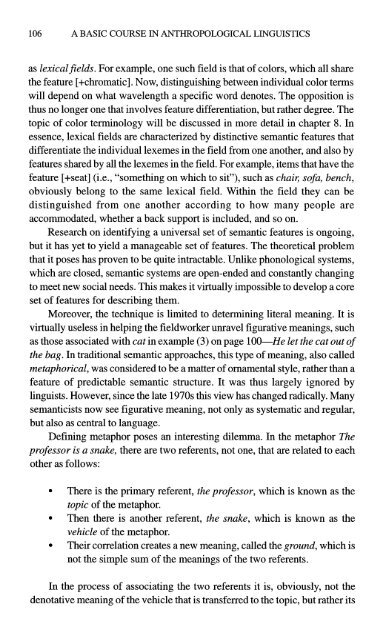A Basic Course in Anthropological Linguistics (Studies in Linguistic ...
A Basic Course in Anthropological Linguistics (Studies in Linguistic ...
A Basic Course in Anthropological Linguistics (Studies in Linguistic ...
You also want an ePaper? Increase the reach of your titles
YUMPU automatically turns print PDFs into web optimized ePapers that Google loves.
106 A BASIC COURSE IN ANTHROPOLOGICAL LINGUISTICS<br />
as lexicalfields. For example, one such field is that of colors, which all share<br />
the feature [+chromatic]. Now, dist<strong>in</strong>guish<strong>in</strong>g between <strong>in</strong>dividual color terms<br />
will depend on what wavelength a specific word denotes. The opposition is<br />
thus no longer one that <strong>in</strong>volves feature differentiation, but rather degree. The<br />
topic of color term<strong>in</strong>ology will be discussed <strong>in</strong> more detail <strong>in</strong> chapter 8. In<br />
essence, lexical fields are characterized by dist<strong>in</strong>ctive semantic features that<br />
differentiate the <strong>in</strong>dividual lexemes <strong>in</strong> the field from one another, and also by<br />
features shared by all the lexemes <strong>in</strong> the field. For example, items that have the<br />
feature [+seat] (i.e., “somethmg on which to sit”), such as chaiq sofa, bench,<br />
obviously belong to the same lexical field. With<strong>in</strong> the field they can be<br />
dist<strong>in</strong>guished from one another accord<strong>in</strong>g to how many people are<br />
accommodated, whether a back support is <strong>in</strong>cluded, and so on.<br />
Research on identify<strong>in</strong>g a universal set of semantic features is ongo<strong>in</strong>g,<br />
but it has yet to yield a manageable set of features. The theoretical problem<br />
that it poses has proven to be quite <strong>in</strong>tractable. Unlike phonological systems,<br />
which are closed, semantic systems are open-ended and constantly chang<strong>in</strong>g<br />
to meet new social needs. This makes it virtually impossible to develop a core<br />
set of features for describ<strong>in</strong>g them.<br />
Moreover, the technique is limited to determ<strong>in</strong><strong>in</strong>g literal mean<strong>in</strong>g. It is<br />
virtually useless <strong>in</strong> help<strong>in</strong>g the fieldworker unravel figurative mean<strong>in</strong>gs, such<br />
as those associated with cat <strong>in</strong> example (3) on page 100-He let the cat out of<br />
the bag. In traditional semantic approaches, this type of mean<strong>in</strong>g, also called<br />
metaphorical, was considered to be a matter of ornamental style, rather than a<br />
feature of predictable semantic structure. It was thus largely ignored by<br />
l<strong>in</strong>guists. However, s<strong>in</strong>ce the late 1970s this view has changed radically. Many<br />
semanticists now see figurative mean<strong>in</strong>g, not only as systematic and regular,<br />
but also as central to language.<br />
Def<strong>in</strong><strong>in</strong>g metaphor poses an <strong>in</strong>terest<strong>in</strong>g dilemma. In the metaphor The<br />
professor is a snake, there are two referents, not one, that are related to each<br />
other as follows:<br />
There is the primary referent, the professor, which is known as the<br />
topic of the metaphor.<br />
Then there is another referent, the snake, which is known as the<br />
vehicle of the metaphor.<br />
Their correlation creates a new mean<strong>in</strong>g, called the ground, which is<br />
not the simple sum of the mean<strong>in</strong>gs of the two referents.<br />
In the process of associat<strong>in</strong>g the two referents it is, obviously, not the<br />
denotative mean<strong>in</strong>g of the vehicle that is transferred to the topic, but rather its






